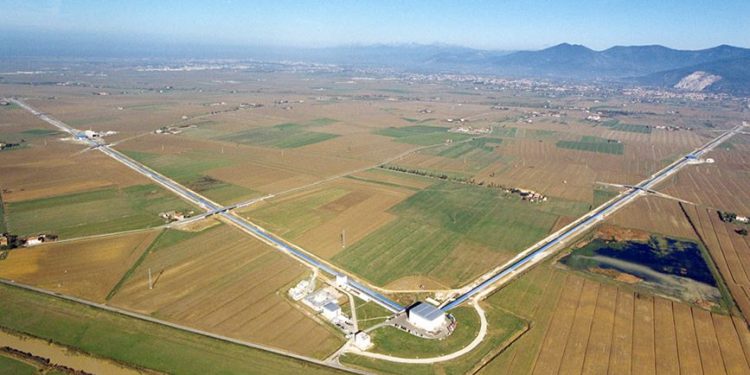New Delhi: LIGO-India will significantly enhance scientists’ ability to pinpoint the sources of gravitational waves — ripples in the fabric of space and time –and answer fundamental questions about the universe, experts say.
The Union Cabinet recently approved the construction of LIGO-India, a 2,600 crore rupee project, in the Hingoli district of Maharashtra that is expected to begin observations by the end of the decade.
Experts say that LIGO-India’s location relative to the other two Laser Interferometer Gravitational-Wave Observatory (LIGO detectors in the US and other gravitational wave detectors around the world will help lend accuracy and precision to gravitational waves’ observation and detection.
The purpose of LIGO detectors, and other gravitational wave (GW) detectors around the world, is to localise the source of gravitational waves.
“(Precisely localising the source) is very important for pointing electromagnetic telescopes to the corresponding patch of sky and look for possible electromagnetic signatures, if present,” said K. G. Arun, who is part of the LIGO-India Scientific Collaboration (LISC).
“This can be achieved only if we have a geographically well-separated global network of detectors and LIGO-India will be extremely crucial for this,” Arun, also professor of Physics, Chennai Mathematical Institute, Tamil Nadu, told PTI.
Localisation of the source in the sky relies on the technique of triangulation, widely used in global positioning system (GPS) navigation. It is the method of determining the position of a fixed point from the angles to it from two fixed points of a known distance apart, using trigonometry.
The method works by calculating the relative delays in GW signal arrival times in multiple detectors.
“Because the detectors are separated by a distance, there is a delay in the arrival time of the signal at the two detectors for a given source, typically milliseconds. This is simply because GWs take slightly more or less time to reach one detector compared to the other.
“This difference changes for different positions in the sky and, therefore, gives us an idea of which part of the sky the signal has come from. This is how the source in the sky is located,” explained Arun.
It is basically the same principle that is used to find our location by accounting for the delays in receiving signals from three or more GPS satellites, said Sanjit Mitra, Professor and LIGO-India Project Coordinator at Inter-University Centre for Astronomy and Astrophysics (IUCAA), Pune.
When the detectors are placed far away, a small change in the direction of the signal source can create significant delays in the signal arrival times, helping in precise sky localisation.
The two US detectors, one in Hanford in eastern Washington and the other in Livingston, Louisiana, are about 3,000 kilometres apart, termed as the baseline distance.
“The inclusion of LIGO-India will create two more baselines with distances over 10,000 kms each. This will improve sky localisation by many folds,” Mitra told PTI over the phone.
Further, to practically realise sky localisation, all the three detectors must have similar sensitivities. LIGO-India will have the same sensitivity as the two other LIGO detectors.
Sensitivity of the detector, which is basically an interferometer, is described by how responsive it is to tiny length changes in its arm lengths, introduced when a gravitational wave is incident on it.
“The interferometer is initially locked into a dark fringe mode, achieved by tuning the arm lengths to make sure there is destructive interference of light,” explained Arun.
Destructive interference leads to a smaller or no resultant wave when two out-of-sync waves are combined, thereby producing a ‘dark fringe’ or no light as output.
“(The incidence of the gravitational wave) shifts the interferometer from dark fringe mode and you detect some light as output,” explained Arun.
“The smallest change in the time taken by light to navigate the interferometer’s arms leads to a change in the instrument’s ‘fringe pattern’. This is how an interferometer gets sensitive to the effect of incident gravitational waves,” said Mitra.
The displacement that LIGO measures due to a passing GW is 1/1000ths of the size of an atomic nucleus, which is extremely small.
“In practice, the sensitivity of the interferometer depends on the frequency of the incoming waves,” said Mitra.
This is because challenges to detect waves can stem from all that can generate “noise” in an interferometer. They can be due to low frequency seismic waves generated partly by human activities.
They could also come from molecules surrounding us, which vibrate from the ambient heat. All this “noise” could significantly impact the performance of LIGO detectors.
“One can quantify the typical noise levels in the detector. A signal has to be well-above these levels to be confidently detected,” said Arun.
Effective noise suppression also governs the distance up to which these waves can be detected in the sky by the interferometer. Further, heavier the mass system of the source, larger the distances they can be observed to.
“The present generation interferometers, such as LIGO, can detect GWs originating from a distance that is several billions of light years. Future upgrades could improve it by roughly 10 fold,” said Arun.
LIGO-India, which makes use of the same technology as the US detectors, is capable of being as sensitive as the LIGO detectors of the US at the time of operating. Each gravitational wave observatory is essentially one large highly sophisticated interferometer.
Eventually, the objective is to have a worldwide network of gravitational waves detectors, the physicists said.
PTI







































